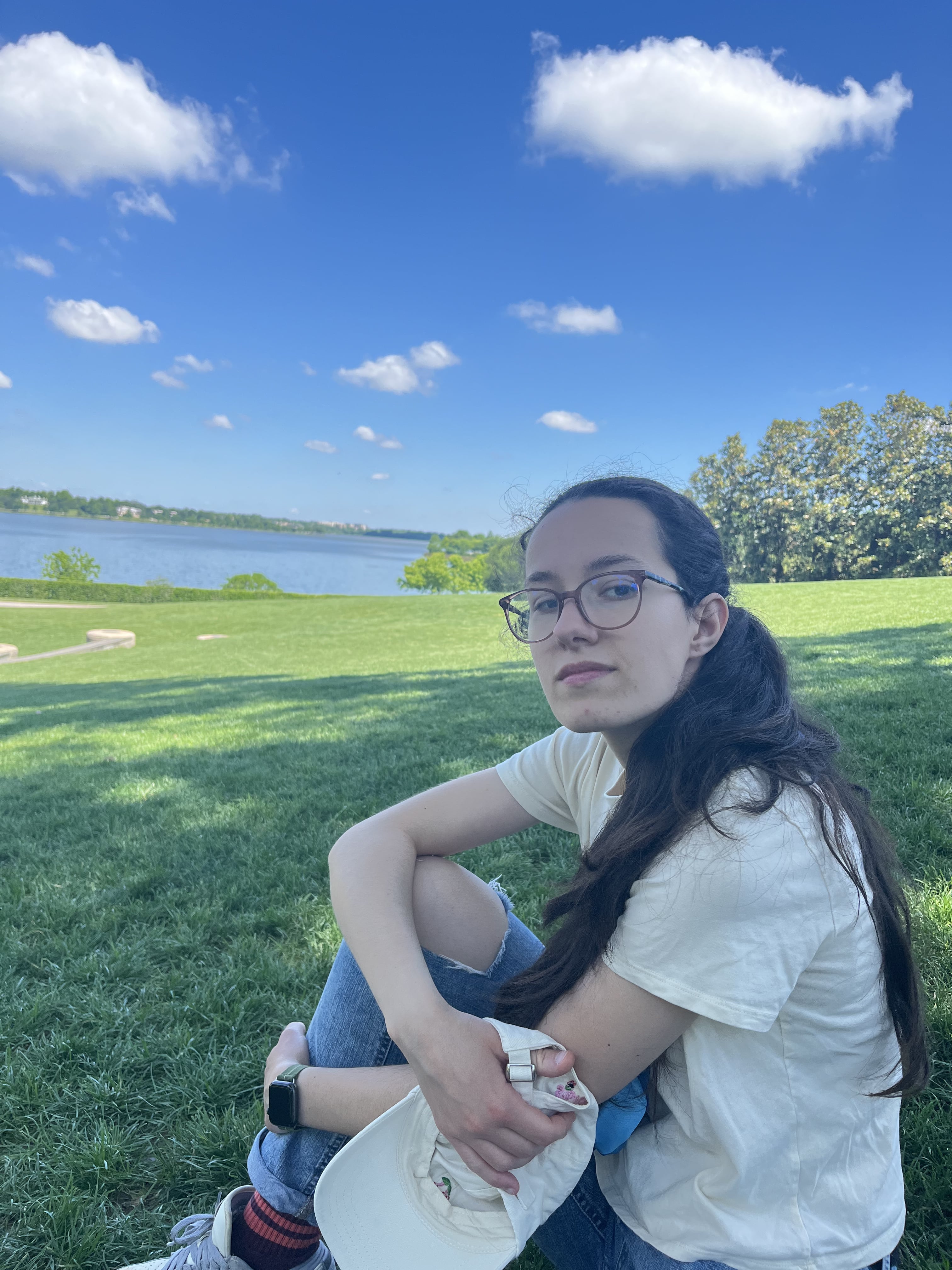Mapping a City Through Its Food
Published:
Where Boston Eats
Boston has so much good food, and every neighborhood feels like it has its own thing going on. I kept wondering—what kinds of restaurants are actually out there? What’s popular, what’s underrated, and where do all the different cuisines live? So I pulled together a bunch of restaurant data to find out.
After collecting business data and enriching it with the google maps api information, I got to labelling each restaurant in the dataset based on its cuisine. Mostly I referred to the cuisine that google maps assigns it to, while trying to capture as many different cuisines with keywords search. This gave me data for about half of all restaurants in Boston, and then I filled in the rest of it by hand.[data sources: City of Boston, Google Maps Places API, and zipcode files]
Boston restaurants encompass over 80 different cuisines, from standards such as Mexican to West Indian, Cape Verdean and Uyghur. Some restaurants are highly specific to a geographic region, e.g. Basque (Zurrito in Beacon Hill) whereas others serve food that is a fusion of different cultures. For instance, many restaurants serve fusion, asian fusion or Latin American cuisine in a blend of food cultures. Others focus on serving food revolving around one ingredient, like chicken (The Port Of Peri Peri) or cheese (Crane River Cheese Club).
All in all, Boston is home to 1400 different restaurants, all offering delicious food from many parts of the world. Where do Bostonians like to go to eat? In which neighborhoods are all these restaurants in?
Mapping the Menu
First, here’s a map of the most common cuisine by zipcode. A lot of neighborhoods are home to many Italian restaurants, particularly the North End which is the city’s Italian neighborhood. You can also see Chinatown in green, as an area with a lot of Chinese restaurants. In Mattapan, a Boston neighborhood with a lot of Caribbean immigrants, the most common type of restaurant is Jamaican.
But some of these places have more than one type of top cuisine, suggesting they have a mix of different restaurants - what is the spread or diversity of cuisines across the rest of the city?
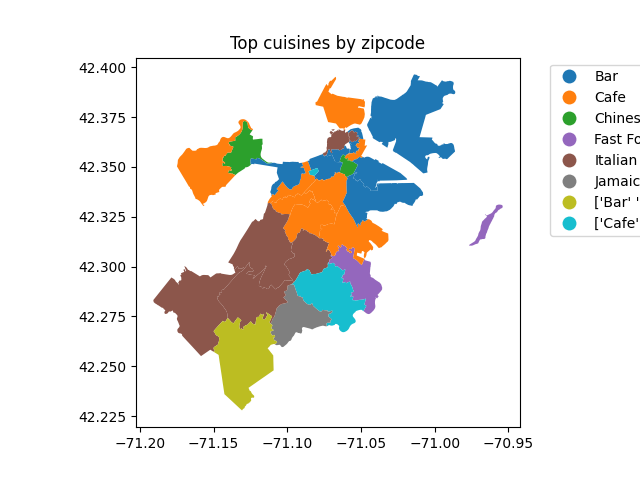
To calculate diversity of cuisines in each zipcode, I used Shannon’s entropy (higher values means a place is more diverse, smaller values suggests that it has a more homogenous set of cuisines). The places with the most cuisine diversity in Boston are the South End, Back Bay and Boston University area. The least diverse neighborhoods are the North End, with its Italian restaurants and Hyde Park, slightly further out from the city:
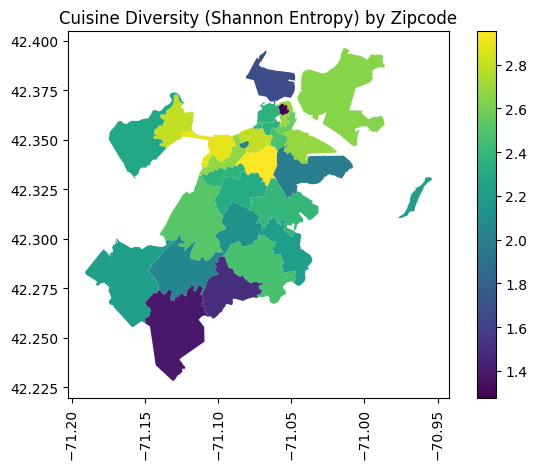
But how about the specific cuisines in each neighborhood? Here’s a map of different and unique cuisines for each zipcode. The Back Bay area has 30 different cuisines, all in a land area of a few square miles. Most other parts of the city are fairly similar in terms of unique cuisines, hovering around 15.
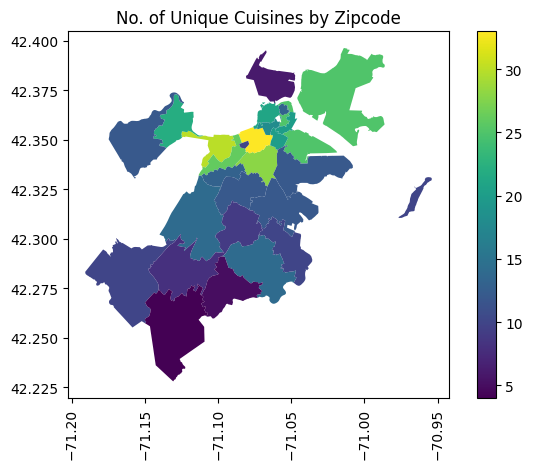
In each of these neighborhoods, the most dominant cuisine makes up 20-30% of all restaurants, except the North End at a pretty impressive 70% of Italian restaurants:
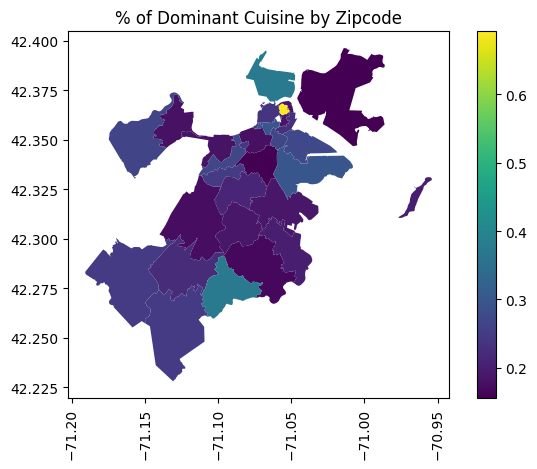
What’s Popular, What’s Loved ❤️
Let’s now turn to another aspect of the food scene in Boston: the popularity of all these different restaurants. Which cuisines are the most popular? Which are the most highly rated? From google reviews, I’ve extracted the number of user reviews and the average ratings (out of 5) for all restaurants in the dataset. For this story, I’m measuring popularity via the review count, so more reviews implies a restaurant is more popular.
How should you use popularity scores to decide shere you should go to eat next time? Let’s break this question down a bit: most places are rated in the low 4, and they typically have a couple hundred reviews. So let’s say that you would like to go somewhere that is ‘underrated’: combining the two metrics, those would be places with a lower number of reviews, but very high average ratings.
Check out this visualization that highlights only those restaurant cuisines. Specifically the criteria I used was ‘higher than 4.4 rating’ and ‘more than 1200 reviews’:
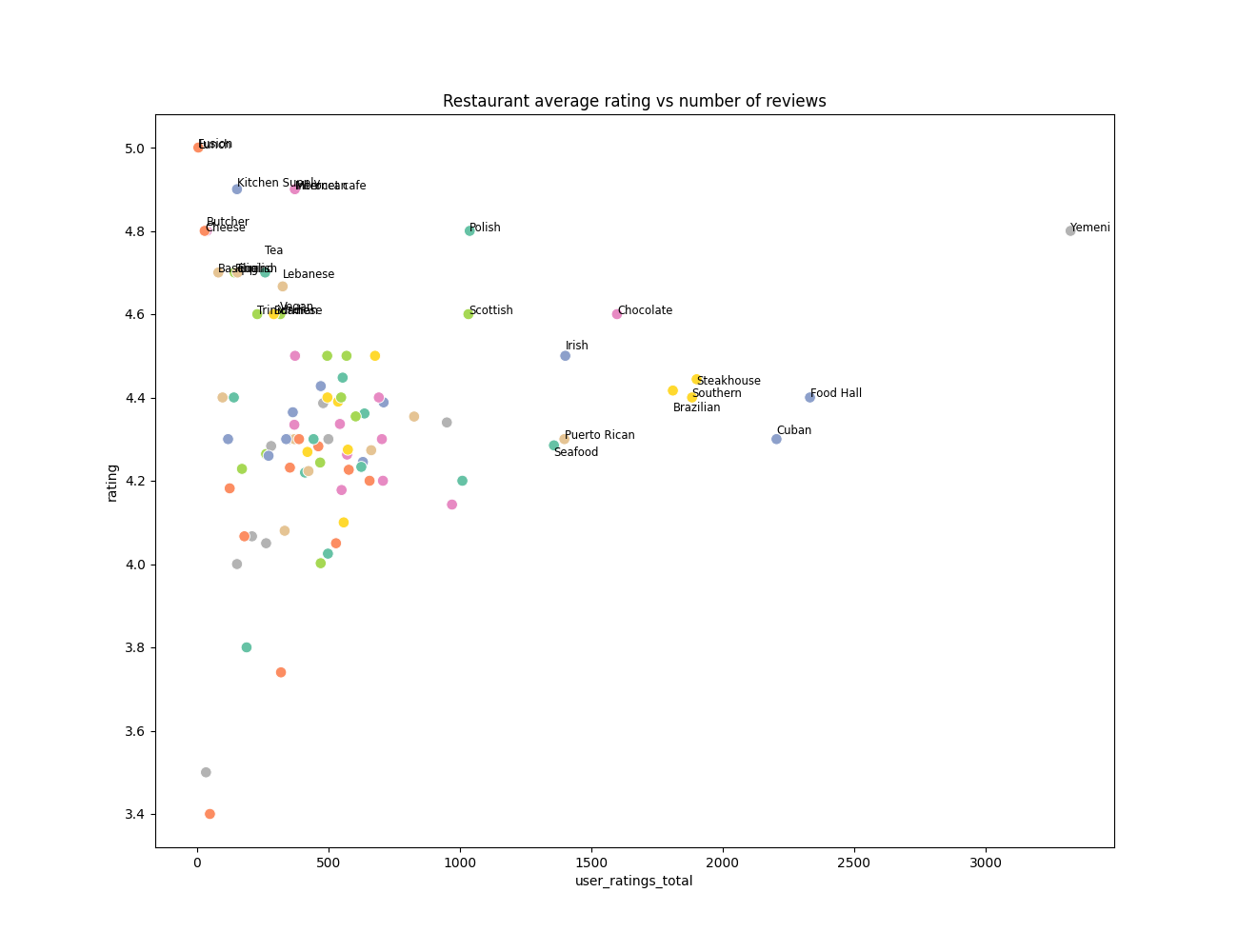
Some cuisines pop out, like Lebanese, Trinidadian and Polish. On the other hand, the one Yemeni dot in the right of the chart corresponds to the only Yemeni restaurant in the city, Bab Al-Yemen in Kenmore Square.
Now, let’s zoom in to the cluster in the middle. This is where most of the cuisines fall, including restaurants as varied as Peruvian, Cape Verdean and even Sushi. Interestingly, ratings for all these restaurants are really similar, even across those that have different numbers of reviews. More popularity doesn’t necessarily mean higher ratings, but rather most cuisines seem to aggregate around a baseline score:

Night Owls vs. Early Closers 🕘
But still, why are certain restaurants more popular? Part of the reason could be convenience and availability, such as having longer opening times. Here’s a plot of opening-closing times on Friday for different cuisines in Boston.
Pizza places stay open the latest, along with particular cuisines like Mediterranean, BBQs and Steakhouses, and Sushi – which stay open until 10 pm on average (that’s still kinda early!) but they also open later, around 11am. Typically restaurants stay open for around 10 or so hours, however brunch places and those serving asian cuisine stay open for 7-8 hours:
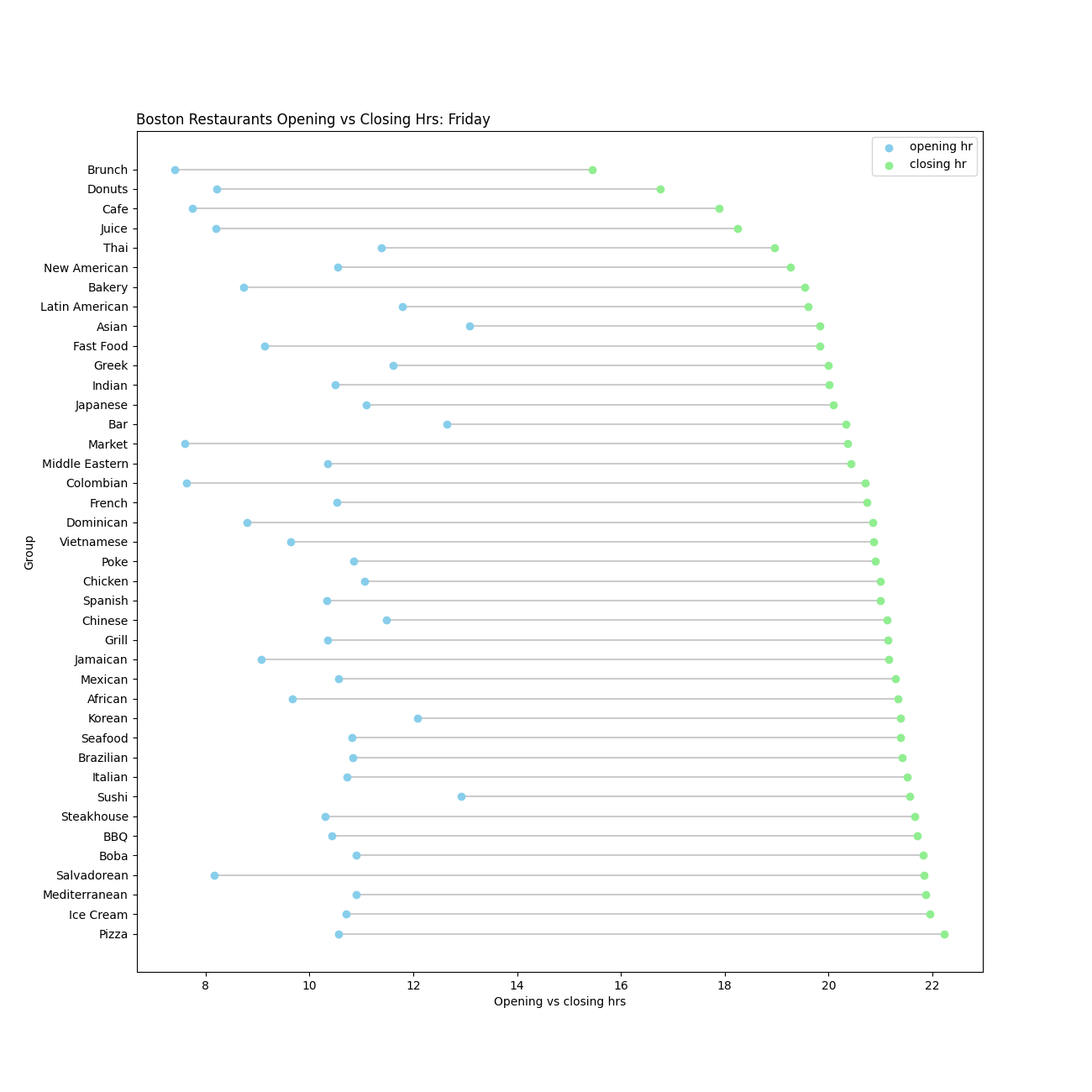
Compare this to a Tuesday: BBQ places are open the latest, whereas Mediterranean spots close slightly earlier:
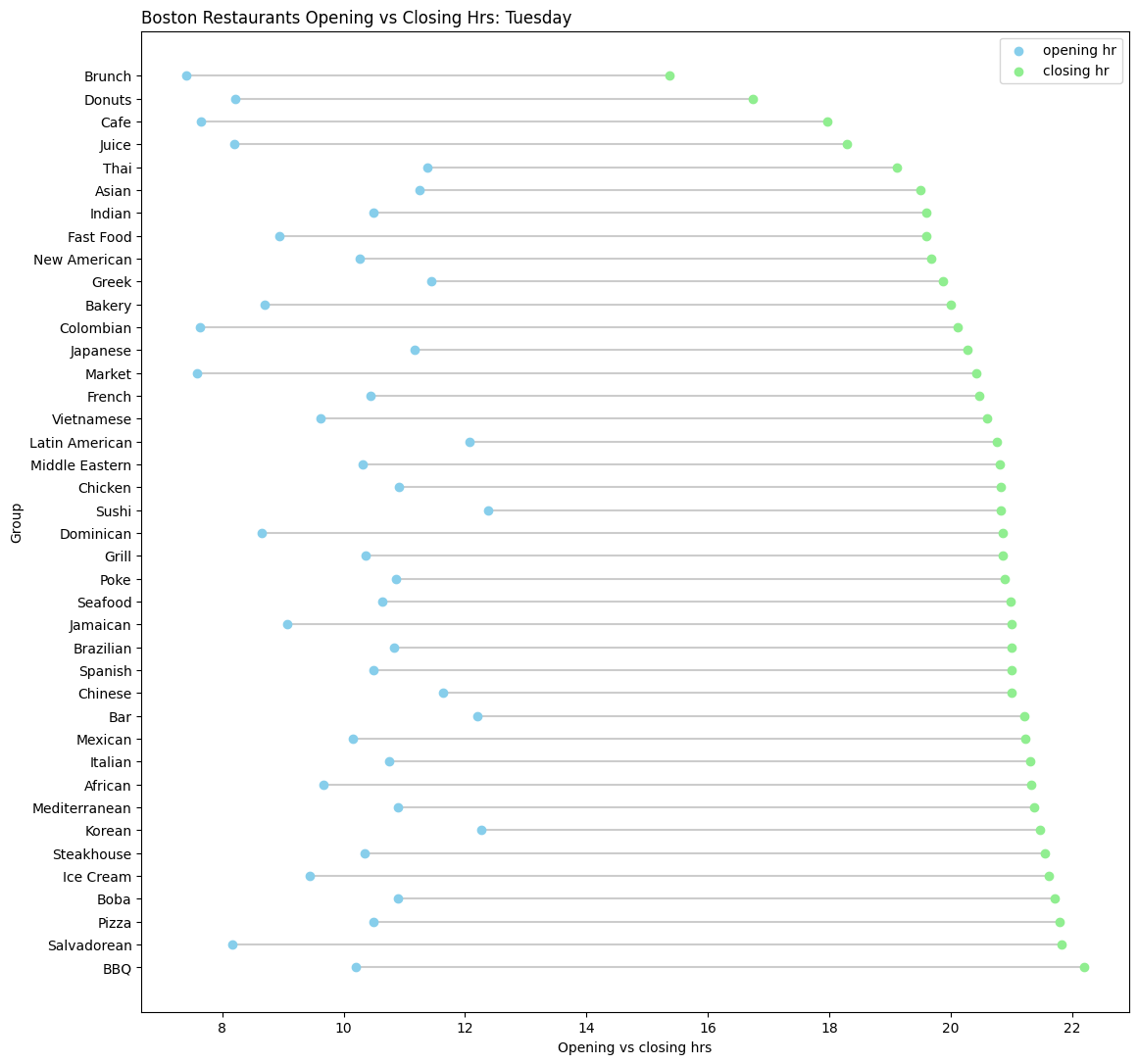
In terms of closing hours by different zipcodes, a lot of Boston restaurants close up around 8pm (!) or earlier (!). With the exception of areas like the North End, East Boston and Dorchester:
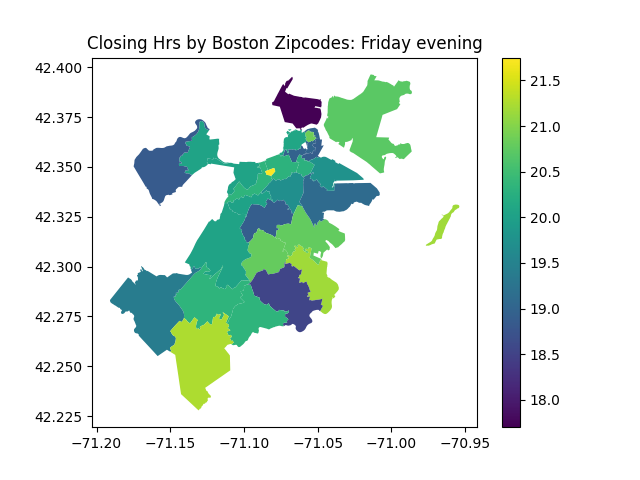
The Price of a Good Meal 💸
Another aspect of popularity is also price levels. Google Maps displays a price point for each restaurant, ranging from 1: \$ to 4: \$\$\$\$. Here are the average price levels for 25 of the 83 cuisines in the dataset:

Steakhouse, Sushi and French are the most expensive cuisines, but a lot of places are rated \$\$ as you can see. Note: Price ratings come from user reviews and are relative, not absolute. They’re meant to reflect perceived expense, not exact menu prices.
Naming the Flavor: What Restaurant Names Reveal 🧠
Besides its price points, reviews and opening hours, Boston’s food scene represents an exciting mix of cultures from all over the world. People open restaurants wanting to preserve their home food and share it with others. It represents their pride for their countries and their desire to build new communities. One big aspect of preserving their culture is also their language and how they use it in their restaurants. In addition, restaurant names are also signifiers for how the restaurant wants to come across and what customers can expect of it. It can signal coolness, expensiveness or just being simple and approachable. and To explore this aspect of food as culture, I looked into the different restaurant names and their patterns.
Here are some questions:
- what is the average length of a restaurant name?
- how many restaurant names include a place mention, i.e. ‘Boston’?
- how many include a number?
- or an ampersand (&)?
- how many include nostalgia words like ‘Old’, ‘Original’, ‘Papa’s’?
- how many names end in ‘cafe’ or ‘grill’?
- how many are only single, hipster-y words?
The chart shows some of the results, aggregated by cuisine. As you can see, names mentioning ‘Boston’ are pretty common, especially for Mediterranean cuisines. A lot of names end in cafe or grill or bar, especially sushi (weird!) or greek (makes more sense). Vietnamese restaurants, on the other hand, tend to include a number in their name, whereas Boba and Indian places tend to have one-word cool names:
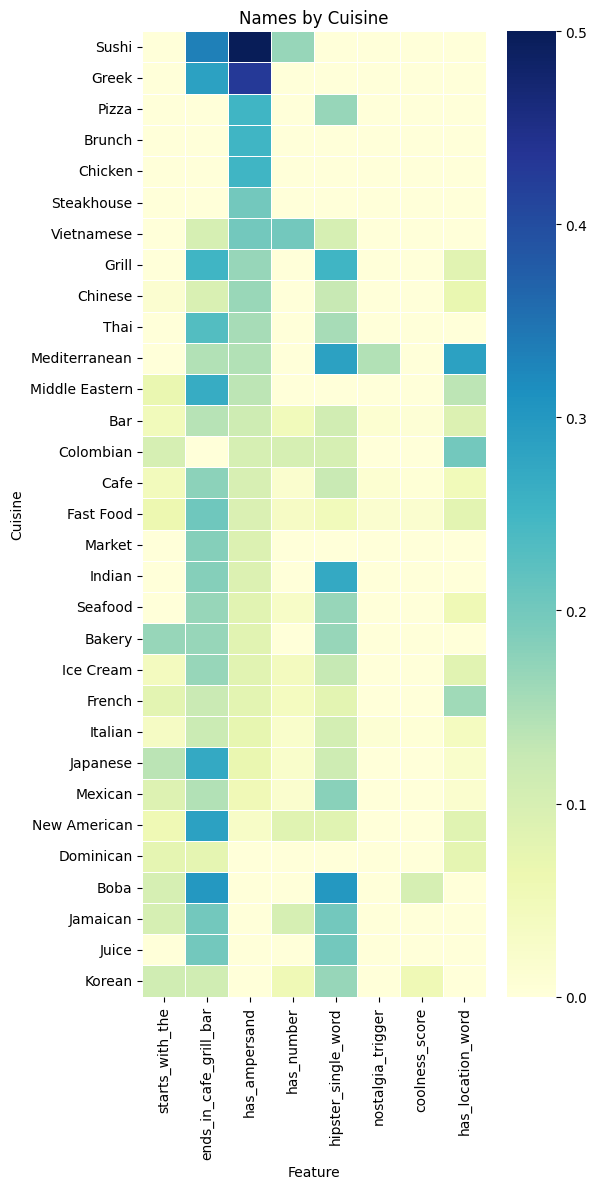
And then, I did the same analysis for the price levels as well. Notice how the most expensive places tend to have many more ampersands than other price points, and they never have any numbers or ‘Boston’ mentions in the name. But having a name that ends in cafe or grill or bar is still pretty common at all price levels:
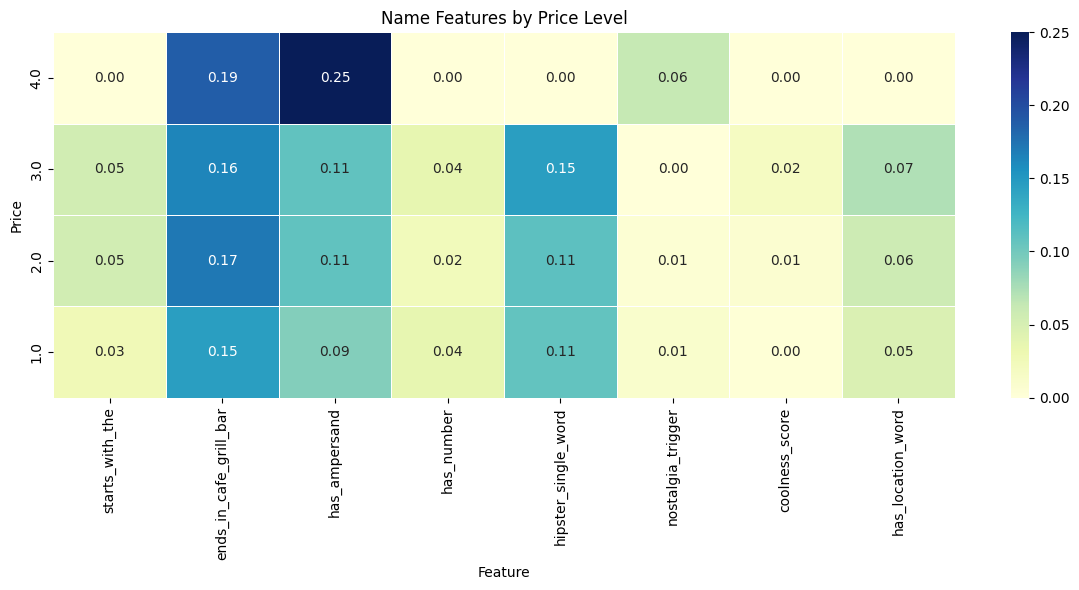
The End of the Menu
Boston’s restaurants tell stories—not just of food, but of migration, identity, and adaptation. From a Polish gem with glowing reviews to a steakhouse with an elegant ampersand, the city’s food scene reflects who we are, where we’ve been, and what we’re craving next.
Bon appétit!
